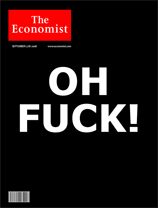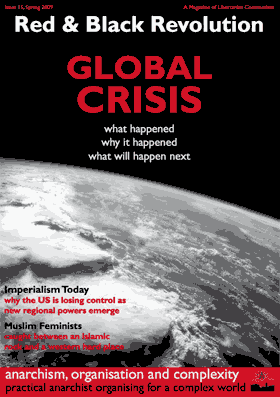Over 30 years of anarchist writing from Ireland listed under hundreds of topics
The neoliberal origins of the global capitalist crisis
 The neoliberal model that global capitalism has depended upon for its growth over the last three decades has collapsed in spectacular fashion. The collapse has been remarkable for the astonishing speed with which it has spread all over the world and into every corner of the global economy.
The neoliberal model that global capitalism has depended upon for its growth over the last three decades has collapsed in spectacular fashion. The collapse has been remarkable for the astonishing speed with which it has spread all over the world and into every corner of the global economy.
The roots of this crisis are found in the basic structure of the neoliberal economic system. Neoliberal economics first came into vogue in the late 1970s. They represented a reaction by the powerful against social democracy and the wave of radical social movements - anti- colonial, civil-rights, feminist, socialist - that flourished in the post-war period. At its essence neoliberalism amounted to a very simple strategy - to remove as many constraints as possible governing how capital could be employed. To this end, from the 1980s onwards, having gained ideological control of the political systems of the major economies, neoliberal financial, legal and diplomatic measures were introduced to progressively facilitate the free movement of capital around the globe. The mobility and freedom from regulation and oversight that such reforms allowed effectively removed any prospect of democratic forces influencing the running of the economy.
If any population even looked like they might have the temerity to impose restrictions on capital movements, the markets would move and capital would leave, destroying the economy in the process, long before the local population could act. If any workforce became too assertive and started organising to achieve better pay and conditions, production could move overseas, closing their factories and eliminating the workers’ jobs. Thus, the basic neoliberal principles, when translated into policies, were very effective in increasing the power of those who owned significant capital and, conversely, decreasing the power of the masses who did not. For example, the rising tide of Third World nationalism and anti-colonialism was militarily impossible to defeat in the 1960s and 70s. However, the Third World debt crisis of the early 1980s managed to quash the threat, with an effect that lasted for decades. Similarly, neoliberal deregulation allowed the industrial barons of the US auto-industry to move production away from the heavily-unionised and militant cities of Detroit and Pittsburgh. The economic dereliction that they left behind still serves as a potent warning against any would be imitators of the militant Detroit workers.
The major problem, however, for the ruling class with this strategy is that the regulations that neoliberalism tore up were put there for a reason and they were largely put in place by the ruling class in their own interests. During the 19th century - the era of classic liberalism - ‘laissez faire’ economic ideas were in vogue. The unregulated economy experienced regular, cataclysmic crises, frequent cycles of boom and bust, social upheavals, resource wars and even revolutions. That economic period culminated in the apocalypse of the First World War and the Russian revolution. The economic mess that ensued led to the Second World War and another surge of social upheaval. The economic regulations, put in place as part of the post-war settlement - which neoliberalism shredded were put in place for a reason.
There are various different theories that explain why markets are prone to cycles of boom and bust. Regardless of the ultimate cause, however, what is clear is that, when people interact through markets, crises invariably occur. The severity and disruption caused by these crises depends on the presence of regulations and mechanisms for preventing them and counter-acting them when they occur. Without any regulation or oversight, markets will frequently collapse completely and will simply cease functioning. In general, regulations that have been put in place exist because, without them, significant problems may occur that threaten the survival of the system. The neoliberal crusaders who constructed the financial infrastructure of the modern economy were presumably at least vaguely aware of the structural problems inherent in deregulated markets. However, they were able to delude themselves into imagining that modern fiscal and monetary policy mechanisms were of such sophistication and power that the government would be able to prevent the system from ever descending into crisis. This belief was seductive too. Neoliberalism delivered almost three decades of solid growth in profits. The frequent crises that appeared, in accordance with their fears, were managed, contained and isolated from the rest of the global economy by the International Financial Institutions. The major economies were largely able to avoid recessions - they were contained within developing regions such as East Asia or Latin America.
However, this apparent success in staving off busts in the major economies was based on a serious dose of both voodoo economics and wishful thinking. Every time that the markets got into trouble, central banks would lower interest rates, making it easier for people to borrow money to keep investments flowing. While it might have looked like it was working at the time, this simply amounted to moving bubbles around and keeping on inflating them whenever they looked like bursting. The dotcom bubble was moved into housing and financial services and, all the while, underlying debt was building up. The entire financial system eventually became little more than a massive pyramid scheme. What made the problem worse was that neoliberalism attacked workers’ incomes and conditions as part of its drive to deliver profits to capitalists. Since modern economies such as that of the US are heavily reliant on consumer spending by workers, this creates a basic contradiction. Thus, during the neoliberal era, a large proportion of consumption as well as investment was fuelled by credit. Low interest rates allowed this dependence on credit to mushroom into a huge bubble.
Credit bubbles can only grow so large. At some stage, debt grows to such a stage that the debtors can’t afford to service their debt. Thus, when interest rates increased in 2007, a chain reaction of debt-defaults was set in motion all across the global economy. It became clear that, rather than having conquered the boom- bust cycle, neoliberalism had simply managed to build up the greatest boom of all time, and its unwinding would be similarly the greatest bust. The immediate factor that triggered the rise in interest rates and the onset of the bust was the increase in commodity prices in 2007 (food, energy, minerals...). This represented a new, underlying and extremely serious long term threat to capitalist growth - the supply of commodities is inherently finite, but capitalist growth demands ever more resources as time goes on. At some stage the raw materials available from the earth will fall below demand. The commodity price bubble of 2007 represented the market’s opinion that the rates of growth were not sustainable in the long term due to the finite nature of supply.
Although the prices of commodities collapsed along with the credit bubble, the spectre of resource shortages hangs over the system. Any recovery of capitalist growth is likely to lead to another explosion in commodity prices.Thus, overall, it is fair to say that the crisis of 2007/2008 represents an enormous and unprecedented challenge to the world’s economic order. As of March 2009, there is no prospect of recovery on the horizon and the pace of the crisis is, if anything, increasing over time, despite the best efforts of bankers and politicians.
Despite the fact that the crisis has and will continue to cause great suffering for ordinary people all over the world, this is a good time to be a revolutionary. The neoliberal capitalist ideological orthodoxy, which reigned supreme for over three decades has been smashed to smithereens and will never return. Suddenly, there is space for new economic visions that are not based upon capitalist greed and growth. Ordinary people are willing to consider different ideas as to how we should run our economy and in many cases, the impossible circumstances that they find themselves in will force them to seek out such answers.Nobody can be sure exactly how the current crisis will play out. We know that it will be severe and prolonged, but exactly what will happen is impossible to know. However, it is obvious that the crisis represents a real opportunity for anarchists and other socialists to rebuild support for alternative economic visions.
A new era of revolutionary possibilities lies before us.
This article was published in Red & Black Revolution, issue 15 Spring 2009. The original article included the two sub articles The development of the crisis and Global Political Repercussions

This article was first published in
Red & Black Revolution 15, Spring 2009
[Download the PDF]

